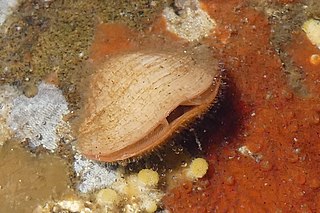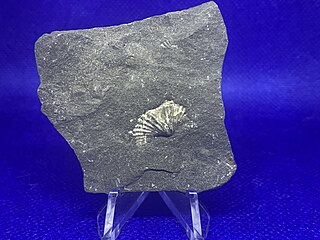
Terebratulids are one of only three living orders of articulate brachiopods, the others being the Rhynchonellida and the Thecideida. Craniida and Lingulida include living brachiopods, but are inarticulates. The name, Terebratula, may be derived from the Latin "terebra", meaning "hole-borer". The perceived resemblance of terebratulid shells to ancient Roman oil lamps gave the brachiopods their common name "lamp shell".
Dictyothyris is an extinct genus of brachiopods that lived from the Middle Jurassic to the Early Cretaceous throughout what is now Europe and North Africa.

Brachiopods, phylum Brachiopoda, are a phylum of trochozoan animals that have hard "valves" (shells) on the upper and lower surfaces, unlike the left and right arrangement in bivalve molluscs. Brachiopod valves are hinged at the rear end, while the front can be opened for feeding or closed for protection. Two major categories are traditionally recognized, articulate and inarticulate brachiopods. The word "articulate" is used to describe the tooth-and-groove structures of the valve-hinge which is present in the articulate group, and absent from the inarticulate group. This is the leading diagnostic skeletal feature, by which the two main groups can be readily distinguished as fossils. Articulate brachiopods have toothed hinges and simple, vertically oriented opening and closing muscles. Conversely, inarticulate brachiopods have weak, untoothed hinges and a more complex system of vertical and oblique (diagonal) muscles used to keep the two valves aligned. In many brachiopods, a stalk-like pedicle projects from an opening near the hinge of one of the valves, known as the pedicle or ventral valve. The pedicle, when present, keeps the animal anchored to the seabed but clear of sediment which would obstruct the opening.

The origin of the brachiopods is uncertain; they either arose from reduction of a multi-plated tubular organism, or from the folding of a slug-like organism with a protective shell on either end. Since their Cambrian origin, the phylum rose to a Palaeozoic dominance, but dwindled during the Mesozoic.

Rhynchonelliformea is a major subphylum and clade of brachiopods. It is roughly equivalent to the former class Articulata, which was used previously in brachiopod taxonomy up until the 1990s. These so-called articulated brachiopods have many anatomical differences relative to "inarticulate" brachiopods of the subphyla Linguliformea and Craniformea. Articulates have hard calcium carbonate shells with tongue-and-groove hinge articulations and separate sets of simple opening and closing muscles.

Spirifer is a genus of marine brachiopods belonging to the order Spiriferida and family Spiriferidae. Species belonging to the genus lived from the Middle Ordovician (Sandbian) through to the Late Triassic (Carnian) with a global distribution. They were stationary epifaunal suspension feeders.

Sphenorhynchia plicatella is an extinct species of brachiopods belonging to the family Prionorhynchiidae.
Juresania is an extinct genus of brachiopod that existed from the Carboniferous to the Permian.
Nanacalathis is a genus of brachiopods belonging to the family Chlidonophoridae.
Bathynanus is a genus of brachiopods belonging to the family Chlidonophoridae.
Chlidonophora is a genus of marine animals in the phylum Brachiopoda belonging to the family Chlidonophoridae.
Eucalathis is a genus of brachiopods belonging to the family Chlidonophoridae.
Melvicalathis is a monotypic genus of brachiopods belonging to the family Chlidonophoridae. The only species is Melvicalathis macroctena.
Notozyga is a genus of brachiopods belonging to the family Chlidonophoridae.
Rectocalathis is a monotypic genus of brachiopods belonging to the family Chlidonophoridae. The only species is Rectocalathis schemmgregoryi.
Phestia is an extinct genus of clam belonging to order Nuculanida and family Nuculanidae.

Mucrospirifer mucronatus is a species of articulate brachiopod from the middle Devonian. The species serves as an index fossil for the middle Devonian.
Deslongchampsithyris is a genus of brachiopods in the family Chlidonophoridae.
Chlidonophora chuni(Blochmann, 1903) is a extant species of brachiopods in the family Chlidonophoridae.
Chlidonophora incerta is a species of brachiopod in the family Chlidonophoridae.






